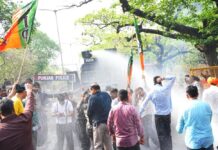



Another ‘First’ added to the credits of PGIMER
As Deptt. of Endocrinology installs Country’s First High-Resolution Peripheral Quantitative Computed Tomography (HR-pQCT) Scanner for patient care
Chandigarh : October 8 : Adding another ‘First in the country’ to the credits of PGIMER, Prof. Jagat Ram, Director PGIMER inaugurated ‘country’s first’ high-resolution peripheral quantitative computed tomography (HR-pQCT) scanner for patient care here at Endocrinology Wing of Nehru Hospital Extension Block here at PGIMER today.
The Inaugural Ceremony was graced by the presence of Sh. Kumar Gaurav Dhawan, Deputy Director (Admn); Sh Kumar Abhay, Financial Adviser, Prof. Sanjay Bhadada, Head, Deptt. of Endocrinology, Prof. Vanita Suri, Head, Deptt. of Obstetrics & Gynecology, Prof. Vipin Kaushal Additional Medical Superintendent, key functionaries, heads of the departments and senior faculty keeping in sync with COVID appropriate behaviour.
Complimenting the Deptt. of Endocrinology on this milestone accomplishment, Prof. Jagat Ram, Director PGIMER stated, “HR-pQCT being non invasive, giving very less radiation and very quick results comparable to bone biopsy which is invasive, painful and time taking, will open new avenue not only in patient management but in clinical and basic research.”
Earlier, while detailing about the multi-pronged usage of this unique scanner, Prof. Sanjay Bhadada, Head, Deptt. of Endocrinology stated, “HR-pQCT is useful for the early diagnosis of many bone disorders like osteoporosis, primary hyperparathyroidism, steroid induced bone damage, bone disease in diabetes, celiac disease, transplant bone disease, bone disease associated with malignancy, bone disease in thyroid and pituitary disorders and other rare metabolic bone diseases.”
Prof. Bhadada further highlighted, “Early diagnosis of bone diseases can help to prevent future fractures. Furthermore, HR-pQCT can be used to monitor improvement in bone health following initiation of treatment which can be picked up as early as 3 months. Besides, HR-pQCT will help us to conduct advanced research in the field of bone disorders,”
“The HR-pQCT is a high-end CT scanner that provides minute details about bone quality, bone mass, and also provide architectural details comparable to bone biopsy. The bones that are usually scanned using HR-pQCT are forearm and leg bone. A HR-pQCT scan entails a radiation exposure of only 5μSv (micro Sievert), which is much less than a standard Chest X-ray and almost one-third that of prevailing background radiation, “ briefed Prof. Bhadada while enumerating the salient features of this high end scanner.











